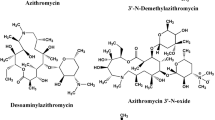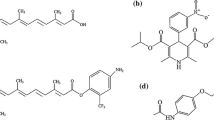Abstract
Solid-phase microextraction (SPME) is an alternative method to dialysis and ultrafiltration for the determination of plasma protein binding (PPB) of drugs. It is particularly advantageous for complicated analytes where standard methods are not applicable. Di-2-pyridylketone 4-cyclohexyl-4-methyl-3-thiosemicarbazone (DpC) is a lead compound of novel thiosemicarbazone anti-cancer drugs, which entered clinical trials in 2016. However, this agent exhibited non-specific binding on filtration membranes and had intrinsic chelation activity, which precluded standard PPB methods. In this study, using a simple and fast procedure, we prepared novel SPME fibers for extraction of DpC based on a metal-free, silicon string support, covered with C18 sorbent. Reproducibility of the preparation process was demonstrated by the percent relative standard deviation (RSD) of ≤ 9.2% of the amount of DpC extracted from PBS by several independently prepared fibers. The SPME procedure was optimized by evaluating extraction and desorption time profiles. Suitability of the optimized protocol was verified by examining reproducibility, linearity, and recovery of DpC extracted from PBS or plasma. All samples extracted by SPME were analyzed using an optimized and validated UHPLC-MS/MS method. The developed procedure was applied to the in vitro determination of PPB of DpC at two clinically relevant concentrations (500 and 1000 ng/mL). These studies showed that DpC is highly bound to plasma proteins (PPB ≥ 88%) and this did not differ significantly between both concentrations tested. This investigation provides novel data in the applicability of SPME for the determination of PPB of chelators, as well as useful information for the clinical development of DpC.

Graphical abstract


Similar content being viewed by others
References
Gorynski K, Gorynska P, Gorska A, Harezlak T, Jaroch A, Jaroch K, et al. SPME as a promising tool in translational medicine and drug discovery: from bench to bedside. J Pharm Biomed Anal. 2016;130:55–67.
Vuckovic D, Zhang X, Cudjoe E, Pawliszyn J. Solid-phase microextraction in bioanalysis: new devices and directions. J Chromatogr A. 2010;1217(25):4041–60.
Boyaci E, Rodriguez-Lafuente A, Gorynski K, Mirnaghi F, Souza-Silva EA, Hein D, et al. Sample preparation with solid phase microextraction and exhaustive extraction approaches: comparison for challenging cases. Anal Chim Acta. 2015;873:14–30.
Bojko B, Cudjoe E, Gomez-Rios GA, Gorynski K, Jiang RF, Reyes-Garces N, et al. SPME - Quo vadis? Anal Chim Acta. 2012;750:132–51.
Musteata FM, Pawliszyn J, Qian MG, Wu JT, Miwa GT. Determination of drug plasma protein binding by solid phase microextraction. J Pharm Sci. 2006;95(8):1712–22.
Vaes WHJ, Ramos EU, Verhaar HJM, Seinen W, Hermens JLM. Measurement of the free concentration using solid-phase microextraction: binding to protein. Anal Chem. 1996;68(24):4463–7.
Heringa MB, Hermens JLM. Measurement of free concentrations using negligible depletion-solid phase microextraction (nd-SPME). Trac-Trend Anal Chem. 2003;22(10):575–87.
Peltenburg H, Bosman IJ, Hermens JL. Sensitive determination of plasma protein binding of cationic drugs using mixed-mode solid-phase microextraction. J Pharm Biomed Anal. 2015;115:534–42.
Riccardi K, Cawley S, Yates PD, Chang C, Funk C, Niosi M, et al. Plasma protein binding of challenging compounds. J Pharm Sci. 2015;104(8):2627–36.
Buscher B, Laakso S, Mascher H, Pusecker K, Doig M, Dillen L, et al. Bioanalysis for plasma protein binding studies in drug discovery and drug development: views and recommendations of the European bioanalysis forum. Bioanalysis. 2014;6(5):673–82.
Lee KJ, Mower R, Hollenbeck T, Castelo J, Johnson N, Gordon P, et al. Modulation of nonspecific binding in ultrafiltration protein binding studies. Pharm Res. 2003;20(7):1015–21.
Kramer NI, van Eijkeren JC, Hermens JL. Influence of albumin on sorption kinetics in solid-phase microextraction: consequences for chemical analyses and uptake processes. Anal Chem. 2007;79(18):6941–8.
Kovacevic Z, Chikhani S, Lovejoy DB, Richardson DR. Novel thiosemicarbazone iron chelators induce up-regulation and phosphorylation of the metastasis suppressor N-myc down-stream regulated gene 1: a new strategy for the treatment of pancreatic cancer. Mol Pharmacol. 2011;80(4):598–609.
Lovejoy DB, Sharp DM, Seebacher N, Obeidy P, Prichard T, Stefani C, et al. Novel second-generation di-2-pyridylketone thiosemicarbazones show synergism with standard chemotherapeutics and demonstrate potent activity against lung cancer xenografts after oral and intravenous administration in vivo. J Med Chem. 2012;55(16):7230–44.
Guo ZL, Richardson DR, Kalinowski DS, Kovacevic Z, Tan-Un KC, Chan GCF. The novel thiosemicarbazone, di-2-pyridylketone 4-cyclohexyl-4-methyl-3-thiosemicarbazone (DpC), inhibits neuroblastoma growth in vitro and in vivo via multiple mechanisms. J Hematol Oncol. 2016;9:98.
Jansson PJ, Kalinowski DS, Lane DJ, Kovacevic Z, Seebacher NA, Fouani L, et al. The renaissance of polypharmacology in the development of anti-cancer therapeutics: inhibition of the "triad of death" in cancer by Di-2-pyridylketone thiosemicarbazones. Pharmacol Res. 2015;100:255–60.
Kalinowski DS, Stefani C, Toyokuni S, Ganz T, Anderson GJ, Subramaniam NV, et al. Redox cycling metals: pedaling their roles in metabolism and their use in the development of novel therapeutics. Biochim Biophys Acta. 2016;1863(4):727–48.
Merlot AM, Kalinowski DS, Richardson DR. Novel chelators for cancer treatment: where are we now? Antioxid Redox Signal. 2013;18(8):973–1006.
Yu Y, Kalinowski DS, Kovacevic Z, Siafakas AR, Jansson PJ, Stefani C, et al. Thiosemicarbazones from the old to new: iron chelators that are more than just ribonucleotide reductase inhibitors. J Med Chem. 2009;52(17):5271–94.
Seebacher NA, Richardson DR, Jansson PJ. A mechanism for overcoming P-glycoprotein-mediated drug resistance: novel combination therapy that releases stored doxorubicin from lysosomes via lysosomal permeabilization using Dp44mT or DpC. Cell Death Dis. 2016;7(12):e2510.
Seebacher NA, Lane DJ, Jansson PJ, Richardson DR. Glucose modulation induces lysosome formation and increases lysosomotropic drug sequestration via the P-glycoprotein drug transporter. J Biol Chem. 2016;291(8):3796–820.
Stacy AE, Palanimuthu D, Bernhardt PV, Kalinowski DS, Jansson PJ, Richardson DR. Zinc(II)-thiosemicarbazone complexes are localized to the lysosomal compartment where they transmetallate with copper ions to induce cytotoxicity. J Med Chem. 2016;59(10):4965–84.
Sestak V, Stariat J, Cermanova J, Potuckova E, Chladek J, Roh J, et al. Novel and potent anti-tumor and anti-metastatic di-2-pyridylketone thiosemicarbazones demonstrate marked differences in pharmacology between the first and second generation lead agents. Oncotarget. 2015;6(40):42411–28.
Stariat J, Sestak V, Vavrova K, Nobilis M, Kollarova Z, Klimes J, et al. LC-MS/MS identification of the principal in vitro and in vivo phase I metabolites of the novel thiosemicarbazone anti-cancer drug, Bp4eT. Anal Bioanal Chem. 2012;403(1):309–21.
FDA. Center for Drug Evaluation and Research (CDER). Bioanalytical method validation guidance for industry. http://www.fda.gov/downloads/Drugs/GuidanceComplianceRegulatoryInformation/Guidances/UCM070107.pdf. Accessed 15 Oct 2018.
Guideline on bioanalytical method validation http://www.ema.europa.eu/docs/en_GB/document_library/Scientific_guideline/2011/08/WC500109686.pdf Accessed 20 Sep 2017.
Fura A, Harper TW, Zhang HJ, Fung L, Shyu WC. Shift in pH of biological fluids during storage and processing: effect on bioanalysis. J Pharm Biomed Anal. 2003;32(3):513–22.
Silvester S, Zang F. Overcoming non-specific adsorption issues for AZD9164 in human urine samples: consideration of bioanalytical and metabolite identification procedures. J Chromatogr B. 2012;893:134–43.
Reyes-Garces N, Bojko B, Hein D, Pawliszyn J. Solid phase microextraction devices prepared on plastic support as potential single-use samplers for bioanalytical applications. Anal Chem. 2015;87(19):9722–30.
Broeders JJ, Blaauboer BJ, Hermens JL. Development of a negligible depletion-solid phase microextraction method to determine the free concentration of chlorpromazine in aqueous samples containing albumin. J Chromatogr A. 2011;1218(47):8529–35.
Poerschmann J, Zhang ZY, Kopinke FD, Pawliszyn J. Solid phase microextraction for determining the distribution of chemicals in aqueous matrices. Anal Chem. 1997;69(4):597–600.
Merlot AM, Sahni S, Lane DJR, Fordham AM, Pantarat N, Hibbs DE, et al. Potentiating the cellular targeting and anti-tumor activity of Dp44mT via binding to human serum albumin: two saturable mechanisms of Dp44mT uptake by cells. Oncotarget. 2015;6(12):10374–98.
Johnson DK, Murphy TB, Rose NJ, Goodwin WH, Pickart L. Cyto-toxic chelators and chelates.1. Inhibition of DNA-synthesis in cultured rodent and human-cells by aroylhydrazones and by a copper(II) complex of salicylaldehyde benzoyl hydrazone. Inorg Chim Acta. 1982;67(5):159–65.
Buss JL, Arduini E, Ponka P. Mobilization of intracellular iron by analogs of pyridoxal. Isonicotinoyl hydrazone (PIH) is determined by the membrane permeability of the iron-chelator complexes. Biochem Pharmacol. 2002;64(12):1689–701.
Bergeron RJ, Wiegand J, Bharti N, Singh S, Rocca JR. Impact of the 3,6,9-trioxadecyloxy group on desazadesferrithiocin analogue iron clearance and organ distribution. J Med Chem. 2007;50(14):3302–13.
Weiss HM, Fresneau M, Camenisch GP, Kretz O, Gross G. In vitro blood distribution and plasma protein binding of the iron chelator deferasirox (ICL670) and its iron complex Fe-[ICL670](2) for rat, marmoset, rabbit, mouse, dog, and human. Drug Metab Dispos. 2006;34(6):971–5.
Dorraji MSS, Azar VP, Rasoulifard MH. Interaction between deferiprone and human serum albumin: multi-spectroscopic, electrochemical and molecular docking methods. Eur J Pharm Sci. 2014;64:9–17.
Merlot AM, Kalinowski DS, Richardson DR. Unraveling the mysteries of serum albumin-more than just a serum protein. Front Physiol. 2014;5:299. https://doi.org/10.3389/fphys.2014.00299.
Ding WQ, Lind SE. Metal ionophores - an emerging class of anticancer drugs. IUBMB Life. 2009;61(11):1013–8.
Torti SV, Torti FM. Iron and cancer: more ore to be mined. Nat Rev Cancer. 2013;13(5):342–55.
Merlot AM, Kalinowski DS, Kovacevic Z, Jansson PJ, Sahni S, Huang ML, et al. Exploiting cancer metal metabolism using anti-cancer metal-binding agents. Curr Med Chem. 2019;26:302–22.
Weekley CM, He C. Developing drugs targeting transition metal homeostasis. Curr Opin Chem Biol. 2017;37:26–32.
Das B, Kandegedara A, Xu LP, Antonio T, Stemmler T, Reith MEA, et al. A novel iron(II) preferring dopamine agonist chelator as potential symptomatic and neuroprotective therapeutic agent for Parkinson's disease. ACS Chem Neurosci. 2017;8(4):723–30.
Dusek P, Schneider SA, Aaseth J. Iron chelation in the treatment of neurodegenerative diseases. J Trace Elem Med Biol. 2016;38:81–92.
Garringer HJ, Irimia JM, Li W, Goodwin CB, Richine B, Acton A, et al. Effect of systemic iron overload and a chelation therapy in a mouse model of the neurodegenerative disease hereditary ferritinopathy. PLoS One. 2016;11(8). https://doi.org/10.1371/journal.pone.0161341.
Orhan IE, Senol FS. Designing multi-targeted therapeutics for the treatment of Alzheimer's disease. Curr Top Med Chem. 2016;16(17):1889–96.
Palanimuthu D, Poon R, Sahni S, Anjum R, Hibbs D, Lin HY, et al. A novel class of thiosemicarbazones show multi-functional activity for the treatment of Alzheimer's disease. Eur J Med Chem. 2017;139:612–32.
Whitnall M, Rahmanto YS, Sutak R, Xu X, Becker EM, Mikhael MR, et al. The MCK mouse heart model of Friedreich's ataxia: alterations in iron-regulated proteins and cardiac hypertrophy are limited by iron chelation. Proc Natl Acad Sci U S A. 2008;105(28):9757–62.
Palanimuthu D, Wu ZX, Jansson PJ, Braidy N, Bernhardt PV, Richardson DR, et al. Novel chelators based on adamantane-derived semicarbazones and hydrazones that target multiple hallmarks of Alzheimer's disease. Dalton Trans. 2018;47(21):7190–205.
Funding
This study was supported by the project EFSA-CDN (No.CZ.02.1.01/0.0/0.0/16_019/0000841) cofunded by ERDF to P.S.K and D.R.R., the Charles University (the Project SVV 260 401) to P.S.K and P.R., and a National Health and Medical Research Council (NHMRC) Project Grant (No. 1060482) and Senior Principal Research Fellowship (APP1062607) to D.R.R.
Author information
Authors and Affiliations
Corresponding authors
Ethics declarations
Ethical approval
Plasma from Wistar rats was obtained from in vivo experiments that were approved and supervised by the Animal Welfare Committee of the Faculty of Pharmacy, Charles University (Czech Republic). All experiments were performed in accordance with Directive 2010/63/EU on the Protection of Animals Used for Scientific Purposes.
Conflict of interest
The authors declare that they have no conflict of interest.
Additional information
Publisher’s note
Springer Nature remains neutral with regard to jurisdictional claims in published maps and institutional affiliations.
Electronic supplementary material
ESM 1
(PDF 323 kb)
Rights and permissions
About this article
Cite this article
Reimerová, P., Stariat, J., Bavlovič Piskáčková, H. et al. Novel SPME fibers based on a plastic support for determination of plasma protein binding of thiosemicarbazone metal chelators: a case example of DpC, an anti-cancer drug that entered clinical trials. Anal Bioanal Chem 411, 2383–2394 (2019). https://doi.org/10.1007/s00216-019-01681-w
Received:
Accepted:
Published:
Issue Date:
DOI: https://doi.org/10.1007/s00216-019-01681-w




